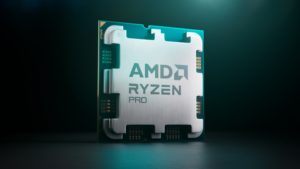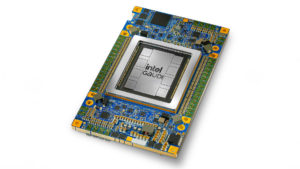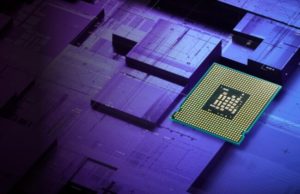Processors for Embedded Vision
THIS TECHNOLOGY CATEGORY INCLUDES ANY DEVICE THAT EXECUTES VISION ALGORITHMS OR VISION SYSTEM CONTROL SOFTWARE
This technology category includes any device that executes vision algorithms or vision system control software. The following diagram shows a typical computer vision pipeline; processors are often optimized for the compute-intensive portions of the software workload.

The following examples represent distinctly different types of processor architectures for embedded vision, and each has advantages and trade-offs that depend on the workload. For this reason, many devices combine multiple processor types into a heterogeneous computing environment, often integrated into a single semiconductor component. In addition, a processor can be accelerated by dedicated hardware that improves performance on computer vision algorithms.
General-purpose CPUs
While computer vision algorithms can run on most general-purpose CPUs, desktop processors may not meet the design constraints of some systems. However, x86 processors and system boards can leverage the PC infrastructure for low-cost hardware and broadly-supported software development tools. Several Alliance Member companies also offer devices that integrate a RISC CPU core. A general-purpose CPU is best suited for heuristics, complex decision-making, network access, user interface, storage management, and overall control. A general purpose CPU may be paired with a vision-specialized device for better performance on pixel-level processing.
Graphics Processing Units
High-performance GPUs deliver massive amounts of parallel computing potential, and graphics processors can be used to accelerate the portions of the computer vision pipeline that perform parallel processing on pixel data. While General Purpose GPUs (GPGPUs) have primarily been used for high-performance computing (HPC), even mobile graphics processors and integrated graphics cores are gaining GPGPU capability—meeting the power constraints for a wider range of vision applications. In designs that require 3D processing in addition to embedded vision, a GPU will already be part of the system and can be used to assist a general-purpose CPU with many computer vision algorithms. Many examples exist of x86-based embedded systems with discrete GPGPUs.
Digital Signal Processors
DSPs are very efficient for processing streaming data, since the bus and memory architecture are optimized to process high-speed data as it traverses the system. This architecture makes DSPs an excellent solution for processing image pixel data as it streams from a sensor source. Many DSPs for vision have been enhanced with coprocessors that are optimized for processing video inputs and accelerating computer vision algorithms. The specialized nature of DSPs makes these devices inefficient for processing general-purpose software workloads, so DSPs are usually paired with a RISC processor to create a heterogeneous computing environment that offers the best of both worlds.
Field Programmable Gate Arrays (FPGAs)
Instead of incurring the high cost and long lead-times for a custom ASIC to accelerate computer vision systems, designers can implement an FPGA to offer a reprogrammable solution for hardware acceleration. With millions of programmable gates, hundreds of I/O pins, and compute performance in the trillions of multiply-accumulates/sec (tera-MACs), high-end FPGAs offer the potential for highest performance in a vision system. Unlike a CPU, which has to time-slice or multi-thread tasks as they compete for compute resources, an FPGA has the advantage of being able to simultaneously accelerate multiple portions of a computer vision pipeline. Since the parallel nature of FPGAs offers so much advantage for accelerating computer vision, many of the algorithms are available as optimized libraries from semiconductor vendors. These computer vision libraries also include preconfigured interface blocks for connecting to other vision devices, such as IP cameras.
Vision-Specific Processors and Cores
Application-specific standard products (ASSPs) are specialized, highly integrated chips tailored for specific applications or application sets. ASSPs may incorporate a CPU, or use a separate CPU chip. By virtue of their specialization, ASSPs for vision processing typically deliver superior cost- and energy-efficiency compared with other types of processing solutions. Among other techniques, ASSPs deliver this efficiency through the use of specialized coprocessors and accelerators. And, because ASSPs are by definition focused on a specific application, they are usually provided with extensive associated software. This same specialization, however, means that an ASSP designed for vision is typically not suitable for other applications. ASSPs’ unique architectures can also make programming them more difficult than with other kinds of processors; some ASSPs are not user-programmable.

AI Decoded: Demystifying Large Language Models, the Brains Behind Chatbots
This blog post was originally published at NVIDIA’s website. It is reprinted here with the permission of NVIDIA. Explore what LLMs are, why they matter and how to use them. Editor’s note: This post is part of our AI Decoded series, which aims to demystify AI by making the technology more accessible, while showcasing new

Intel Builds World’s Largest Neuromorphic System to Enable More Sustainable AI
Hala Point, the industry’s first 1.15 billion neuron neuromorphic system, builds a path toward more efficient and scalable AI. What’s New: Today, Intel announced that it has built the world’s largest neuromorphic system. Code-named Hala Point, this large-scale neuromorphic system, initially deployed at Sandia National Laboratories, utilizes Intel’s Loihi 2 processor, aims at supporting research for future brain-inspired artificial

Arm’s Mission to Help Tackle AI’s Insatiable Energy Needs
This blog post was originally published at Arm’s website. It is reprinted here with the permission of Arm. The challenge (and opportunity) of powering workloads in the AI datacenter AI has the potential to exceed all the transformative innovations created in the past century. The benefits to society around health care, productivity, education and many

How Embedded Vision is Helping Build Smart Buses of the Future
This blog post was originally published at TechNexion’s website. It is reprinted here with the permission of TechNexion. The transportation sector has always been at the forefront of technological advancements, and the emergence of the “Smart Bus” system is a testament to this evolution. This innovative system is not just about enhancing the passenger experience

Edge AI and Vision Alliance Conversation with GenAI Nerds on Generative AI At the Edge
Kerry Shih of GenAI Nerds interviews Jeff Bier, Founder of the Edge AI and Vision Alliance, and Phil Lapsley, the Alliance’s Vice President of Business Development, about the opportunities and trends for generative AI at the edge. Shih, Bier and Lapsley discuss topics such as: Where we are in the generative AI hype cycle What

AMD Expands Commercial AI PC Portfolio to Deliver Leadership Performance Across Professional Mobile and Desktop Systems
AMD Ryzen™ PRO 8040 Series and AMD Ryzen™ PRO 8000 Series provide businesses with the most advanced x86 processors1 for AI PCs SANTA CLARA, Calif., April 16, 2024 (GLOBE NEWSWIRE) — Today, AMD (NASDAQ: AMD) announced new products that will expand its commercial mobile and desktop AI PC portfolio, delivering exceptional productivity and premium AI

Microchip Technology Acquires Neuronix AI Labs
Innovative technology enhances AI-enabled intelligent edge solutions and increases neural networking capabilities CHANDLER, Ariz., April 15, 2024 — Microchip Technology (Nasdaq: MCHP) has acquired Neuronix AI Labs to expand its capabilities for power-efficient, AI-enabled edge solutions deployed on field programmable gate arrays (FPGAs). Neuronix AI Labs provides neural network sparsity optimization technology that enables a

Partitioning Strategies to Optimize AI Inference for Multi-core Platforms
This blog post was originally published at Ceva’s website. It is reprinted here with the permission of Ceva. Not so long ago, AI inference at the edge was a novelty easily supported by a single NPU IP accelerator embedded in the edge device. Expectations have accelerated rapidly since then. Now we want embedded AI inference

Exploring the Impact of Generative AI: Identifying the Winners
This market research report was originally published at the Yole Group’s website. It is reprinted here with the permission of the Yole Group. Datacenter GPU and AI ASIC revenue could reach $156 billion by 2025 and $233 billion by 2029. OUTLINE The massive growth that the data center GPU and AI ASIC market experienced in

AI Chips and Chat GPT: Exploring AI and Robotics
AI chips can empower the intelligence of robotics, with future potential for smarter and more independent cars and robots. Alongside the uses of Chat GPT and chatting with robots at home, the potential for this technology to enhance working environments and reinvent socializing is promising. Cars that can judge the difference between people and signposts

Efficiently Packing Neural Network AI Model for the Edge
This blog post was originally published at Ceva’s website. It is reprinted here with the permission of Ceva. Packing applications into constrained on-chip memory is a familiar problem in embedded design, and is now equally important in compacting neural network AI models into a constrained storage. In some ways this problem is even more challenging

AI Decoded From GTC: The Latest Developer Tools and Apps Accelerating AI on PC and Workstation
This blog post was originally published at NVIDIA’s website. It is reprinted here with the permission of NVIDIA. Next Chat with RTX features showcased, TensorRT-LLM ecosystem grows, AI Workbench general availability, and NVIDIA NIM microservices launched. Editor’s note: This post is part of the AI Decoded series, which demystifies AI by making the technology more

The Rise of Generative AI: A Timeline of Breakthrough Innovations
This blog post was originally published at Qualcomm’s website. It is reprinted here with the permission of Qualcomm. Explore the most pivotal advancements that shaped the landscape of generative AI From Alan Turing’s pioneering work to the cutting-edge transformers of the present, the field of generative artificial intelligence (AI) has witnessed remarkable breakthroughs — and

Micron’s Full Suite of Automotive-grade Solutions Qualified for Qualcomm Automotive Platforms to Power AI in Vehicles
Micron’s automotive memory and storage enable central compute, digital cockpit and advanced driver-assistance systems for Qualcomm customers NUREMBERG, Germany, April 10, 2024 (GLOBE NEWSWIRE) — Embedded World — Micron Technology, Inc. (Nasdaq: MU), today announced that it has qualified a full suite of its automotive-grade memory and storage solutions for Qualcomm Technologies Inc.’s Snapdragon® Digital Chassis™,

Advantech Establishes Collaboration with Qualcomm to Shape the Future of the Edge
Taipei, Taiwan and Nuremberg, Germany, 10th April 2024 — Today, at Embedded World, Advantech proudly announced its strategic collaboration with Qualcomm Technologies, Inc. to revolutionize the edge computing landscape. This effort, combining AI expertise, high-performance computing, and industry-leading connectivity, is set to propel innovation for industrial computing. This collaboration establishes an open and diverse edge

Axelera Uses oneAPI Construction Kit to Rapidly Enable Open Standards Programming for the Metis AIPU
AI applications have an endless hunger for computational power. Currently, increasing the sizes of the models and cranking up the number of parameters has not quite yet reached the point of diminishing returns and thus the ever growing models still yield better performance than their predecessors. At the same time, new areas for application of

Intel Breaks Down Proprietary Walls to Bring Choice to Enterprise GenAI Market
Intel Gaudi 3 AI accelerator brings global enterprises choice for generative AI, building on the performance and scalability of its Gaudi 2 predecessor. What’s New: At Intel Vision, Intel introduces the Intel® Gaudi® 3 AI accelerator, which delivers 4x AI compute for BF16, 1.5x increase in memory bandwidth, and 2x networking bandwidth for massive system

Qualcomm Announces Breakthrough Wi-Fi Technology and Introduces New AI-ready IoT and Industrial Platforms at Embedded World 2024
Highlights: Qualcomm Technologies’ leadership in connectivity, high performance, low power processing, and on-device AI position it at the center of the digital transformation of many industries. Introducing new industrial and embedded AI platforms, as well as micro-power Wi-Fi SoC—helping to enable intelligent computing everywhere. The Company is looking to expand its portfolio to address the

Imagination’s New Catapult CPU is Driving RISC-V Device Adoption
Imagination APXM-6200 CPU: The performance-dense RISC-V application processor for Intelligent, Consumer and Industrial Applications 08 April 2024 – Imagination Technologies today unveils the next product in the Catapult CPU IP range, the Imagination APXM-6200 CPU: a RISC-V application processor with compelling performance density, seamless security and the artificial intelligence capabilities needed to support the compute

AMD Extends Leadership Adaptive SoC Portfolio with New Versal Series Gen 2 Devices Delivering End-to-end Acceleration for AI-driven Embedded Systems
First devices in AMD Versal Series Gen 2 portfolio target up to 3x higher TOPs-per-watt with next-gen AI Engines and up to 10x more CPU-based scalar compute than first generation Subaru among first customers to announce plans to deploy AMD Versal AI Edge Series Gen 2 to power next-gen ‘EyeSight’ ADAS vision system NUREMBERG, Germany,

